
Whooping crane (Grus americana), Overstreet Landing Park. |
Florida, part 13: Wading birds (continued) and seabirds
The tallest bird in Florida is whooping crane. The native non-migratory population had been hunted to extinction by Native Americans before the European arrival, and wintering flocks disappeared soon after it. A small reintroduced flock (just over 50 birds) exists in central Florida, but it isn't doing very well due to high mortality and low breeding success. Another population is being established in Wisconsin; these birds are being taught by ultralight aircraft to migrate to Florida for winter.
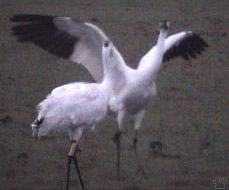 |
 |
 |
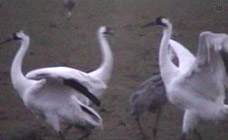 |
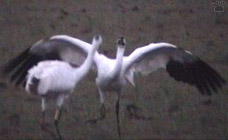 |
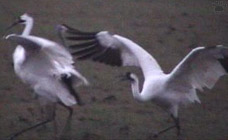 |
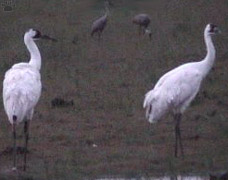 |
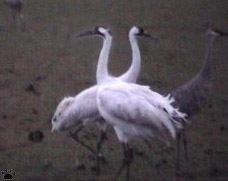 |
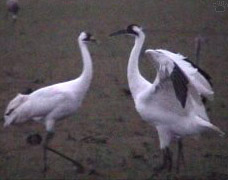 |
 |
 |
 |
| Whooping cranes dancing at dawn, Joe Overstreet Rd. |
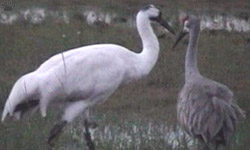
Sandhill (G. canadensis) and whooping crane, JOR. |
Smaller sandhill cranes breed in wet prairies of central and northern Florida; many more come from eastern Canada to winter. Wintering birds sometimes show up in cities, especially along the eastern coast. |
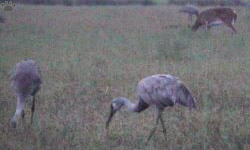
Sandhill cranes and a white-tailed deer, JOR. |
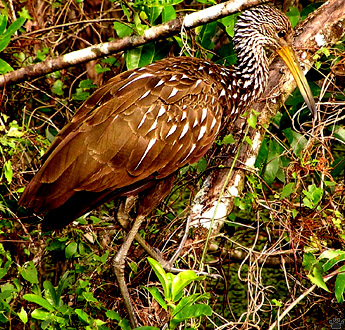 |
 |
| Limpkin (Aramus guarauna) is a primitive crane that looks more like a large rail. Everglades National Park. |

Clapper rail (Rallus longirostris) with a chick, Big Pine Key. |
There are nine species of rails in Florida, but the smaller ones are nocturnal and difficult to find in tall marsh grass. Sometimes you can see them from park boardwalks late at night or at dusk. |
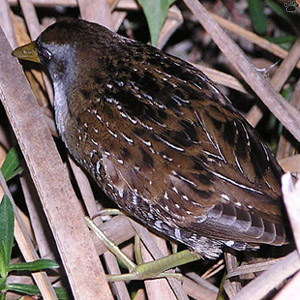
Sora (Porzana carolina), ENP. |
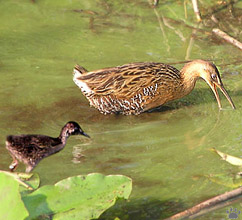 |
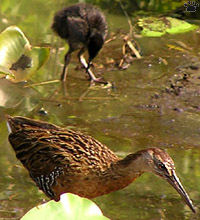 |
 |
| King rails (R. elegans), ENP. |
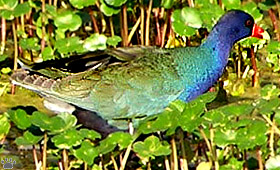
Purple gallinule (Gallinula martinica), ENP. |
Two large aquatic species - purple gallinule and common moorhen - are very common in freshwater marshes, and hard to miss on any visit to the Everglades. |
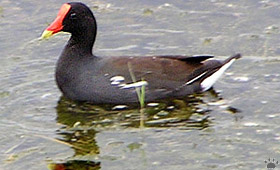
Common moorhen (G. chloropus), ENP. |
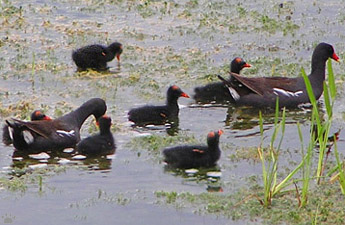 |
 |
| Adult (left) and juvenile moorhens with chicks, Arthur R. Marshall Loxahatchee National Wildlife Refuge. |
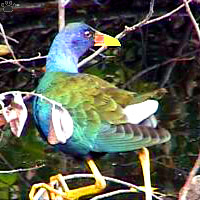
Purple gallinule, ENP. |
Unlike them, American coot is mostly a winter visitor to the state.
|
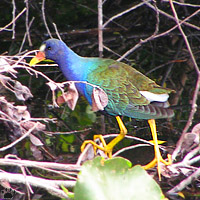
Purple gallinule, ENP. |
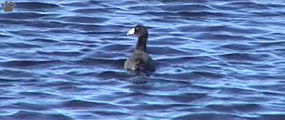
American coot (Fulica Americana), Lake Okeechobee. |
| But adults are less shy and easier to see near Shark Valley parking lot. |

Ruddy turnstone (Arenaria interpres), Crandon Park, Key Biscaine. |
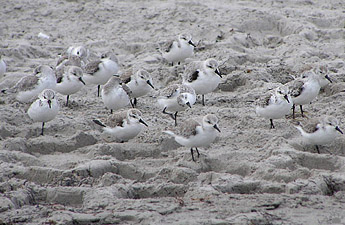
Sanderlings (Calidris alba), Crandon Park. |

Parasitic jaeger (Catharacta parasitica),
Gulf Stream off Florida. |
Most species of waders, gulls and jaegers are also winter visitors, while shearwaters and storm-petrels are more common offshore in spring and summer.
|
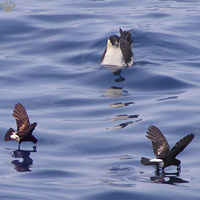
Parasitic jaeger and Wilson's storm-petrels
(Oceanites oceanicus), Gulf Stream off Florida. |

Sooty shearwaters (Puffinus griseus),
Gulf Stream off Florida. |

Laughing gull (Larus atricilla), Daytona Beach. |
Laughing gull is common on local shores year-round. It has recently begun nesting on Dry Tortugas, feeding on eggs and chicks of other seabirds in summer and on garbage provided by tourists in winter. |
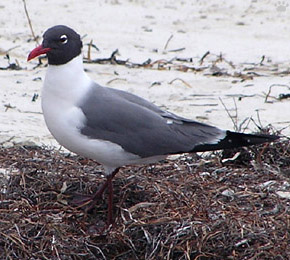
Laughing gull, Garden Key, Dry Tortugas. |
 |
 |
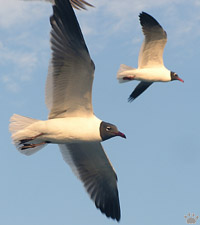 |
| Laughing gulls sometimes feed on large insects around city lights. Daytona Beach. |
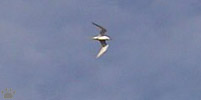
Least tern (Sterna antillarum), Marathon. |
Florida has no less than twelve species of terns, but only three of them breed on the mainland and three - on Dry Tortugas. Two small species sometimes nest on the roofs of city buildings, such as the government building in the city of Marathon on the Keys. |
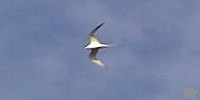
Roseate tern (S. dougallii), Marathon, Vaca Key. |
 |
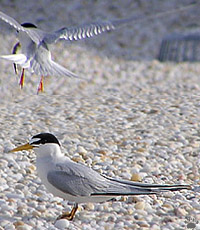 |
 |
| Least terns and their rooftop nests, Marathon. |

Royal terns (S. maxima), St. Petersburg, Florida. |
Of the large terns, royal tern is the most common. In winter this beautiful bird frequents beaches, piers and coastal bridges. |
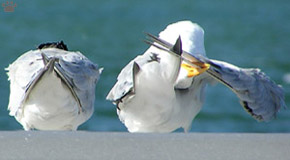
Royal terns, St. Petersburg, Florida. |
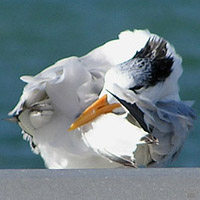
Royal tern, St. Petersburg. |
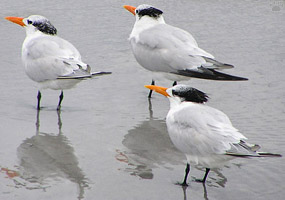
Royal terns, Miami. |
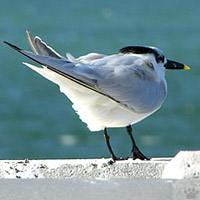
Sandwich tern (S. sandvicensis), St. Petersburg. |

Royal tern, St. Petersburg. |
In winter, up to twenty bird species can be seen on Miami beaches in one evening walk. |
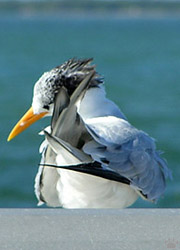
Royal tern, St. Petersburg. |
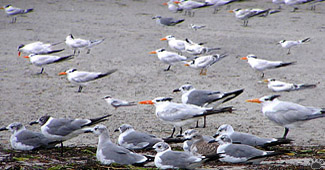
Laughing gulls, royal and least terns, Crandon Park. |
| If you are lucky, you might spot a rare Arctic wader, or a vagrant tropical bird. |

Royal and Sandwich terns, a laughing gull and a black skimmer (Rynchops niger), Crandon Park. |
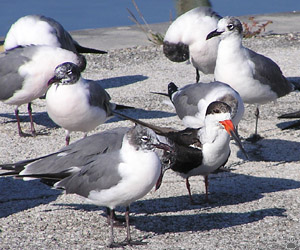
Black skimmer and laughing gulls, ENP. |
Skimmers are also coastal birds, but they can be seen on large lakes in the Everglades. They usually feed at night and roost on sandy shoals during the day. |
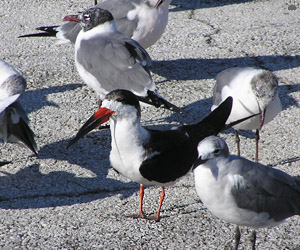
Black skimmer and laughing gulls, ENP. |

Brown noddies (Anous stolidus), Garden Key, Dry Tortugas. |
Part 14. Owls and nightjars
Back to Part 12
Home
|























































